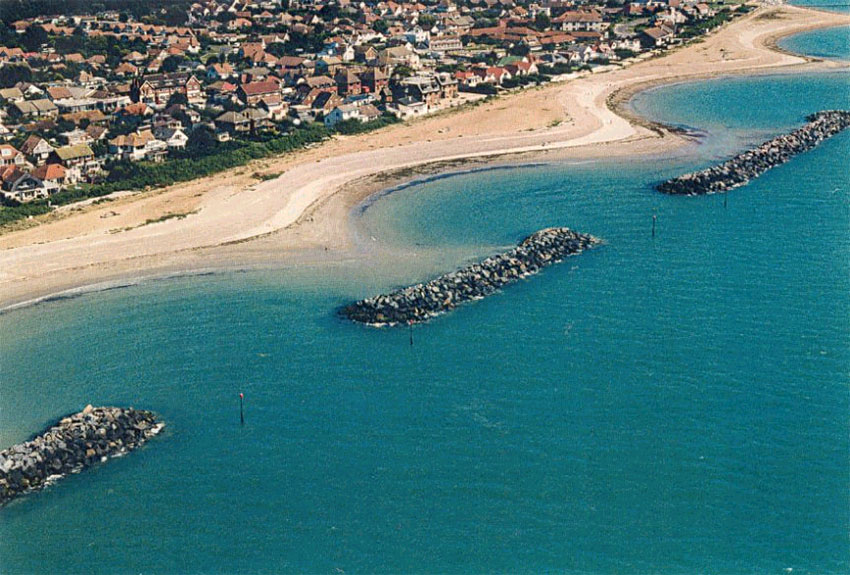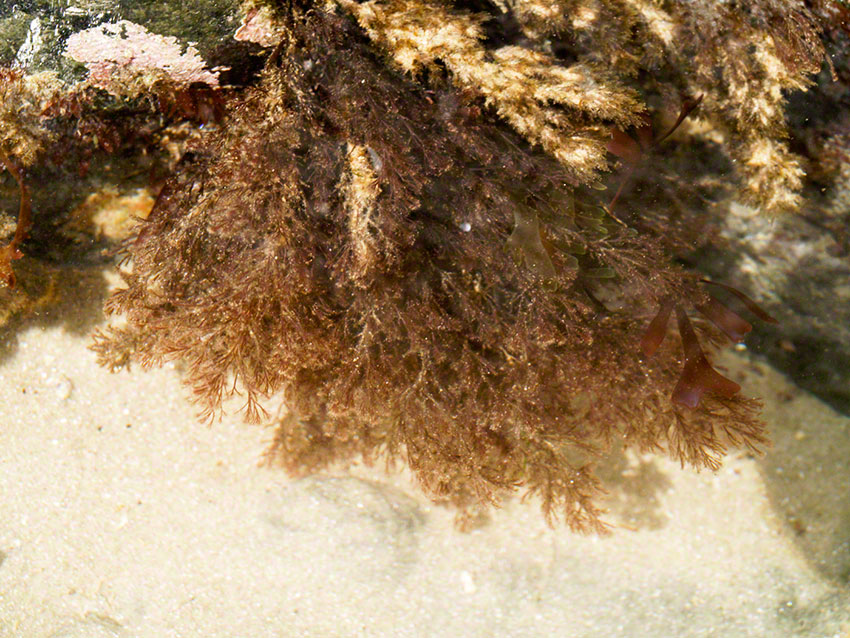The old wooden groynes at Elmer proved ineffective in maintaining the shingle beach. In order to address the problem offshore breakwaters were installed. The shore defences at Elmer are examples of these breakwaters (see South Downs Coastal Group).
This approach as been used to stabilise the coastline at a number of places in the UK including Leasowe Bay on the Wirral, Monk’s Bay on the Isle of Wight, between Happisburgh and Winterton in Norfolk, and at Elmer, West Sussex. The bulk of the work was carried out 1992/3 involving 200,000 cubic metres of shingle and 100,000 tonnes of rock.
Each ‘breakwater’ is created by forming ‘reefs’ from mounds of rubble and represent a simple design solution for the stabilisation of the renourished frontage at Elmer. The breakwaters reduce wave energy in the lee of the structures allowing the beach to evolve into a responsive barrier stopping the sea from overtopping the old seawall with subsequent flooding but allowing some littoral drift to carry on. Sand and gravel salients (coastal formation of beach material resulting from wave refraction and diffraction) have formed in the lee of each breakwater separated by broad embayments.
Drift is reduced considerably compared to the open coast, but studies have demonstrated that some sediment may pass through the scheme at the salients. The salient and bay systems developed to a greater degree than was originally anticipated and some remedial works have been required. By 2001 the scheme had very effectively intercepted drift from the west and a wide stable foreshore has formed along this sector.
For further information see: Ecological impact of coastal defense structures on sediment and mobile fauna... Advances in Coastal Structures... and Application of Offshore Breakwaters to the UK: A Case Study at Elmer Beach
Sponges
Halichondria panicea Breadcrumb sponge
Dysidea fragilis Goosebump sponge
Cnidaria
Actinia equina Beadlet anemone Both red and green varieties
Anemonia viridis Snakelocks anemone Both green / purple and grey varieties
Actinothoe sphyrodeta Sandaled anemone White anemone in deep crevices
Sertularia sp Whiteweed
Dynamena pumila a seafir
Kirchenpaueria pinnata a seafir
Worms
Lanice conchilega Sand mason
Arenicola marina Lugworm
Spirorbis sp Spiral worm
Eulalia vividis Green leafworm, eggs
Molluscs
Crepidula fornicata Slipper limpet
Gibbula cineraria Grey top shell
Gibbula umbilicalis Purple top shell
Littorina saxatilis Rough winkle
Littorina littorea Edible winkle
Nucella lapillus Dog whelk
Patella vulgata Limpet
Pholas dactylus Piddock, holes
Buccinum undatum Common whelk, eggs; drift only
Mytillus edulis Blue mussel
Crustacea
Carcinas maenas Shore crab
Austrominius modestus Darwin’s barnacle
Pagurus bernhardus Hermit crab
Palaemon elegans A prawn
Bryozoa
Electra pilosa Frosty sea mat
Bugula sp
Sea squirts
Styela clava Leathery sea squirt, drift only
Corella eumyota a sea squirt
Ascidiella sp. a sea squirt, drift only
Fish
Juvenile flatfish ? Pleuronectes platessa, Plaice
Fish fry
Scyliorhinus canicula Lesser spotted dogfish/Cat Shark, eggcase
Ray eggcases
Seaweeds/algae
Saccharina latissima Sugar kelp
Enteromorpha sp Gutweed
Ulva lactuca Sea lettuce
Fucus serratus Serrated wrack
Fucus vesiculosus Bladderwrack
Chondrus crispus Irish Moss
Corallina officinalis Coralweed
Hildenbrandia sp
Crustose pink algae various species
Furcellaria lumbricus Clawed Fork Weed
Colpomenia peregrina Oyster Thief * interesting record
Mastocarous stellatus Grape Pip Weed, drift only
Should you wish to contact me:

Unless otherwise stated all images are Copyright of Gerald Legg, naturaimaging. If you would like to use any images, then high resolution ones can be obtained by contacting me.
This work is licensed under a Creative Commons Attribution-ShareAlike 3.0 Unported License.











